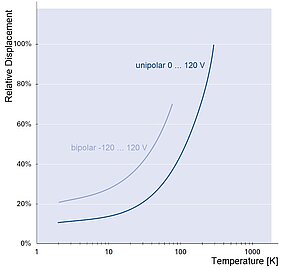Below the Curie temperature, the temperature dependence of the remnant strain and the coercive field strength is decisive for the temperature behavior. Both the attainable displacement with electric operation and the dimensions of the piezoceramic element change depending on the temperature.
The cooler the piezo actuator, the greater the remnant strain Srem and the coercive field strength Erem (fig. 1).
The curves become increasingly flatter with decreasing temperatures. This causes the strain induced by a unipolar control to become smaller and smaller even though the total amplitude of the bipolar strain curve hardly changes over wide temperature ranges. The lower the temperature, the greater the remnant strain. All in all, the piezo ceramic has a negative thermal expansion coefficient, i.e., the piezo ceramic becomes longer when it cools down. In comparison: A technical ceramic contracts with a relatively low thermal expansion coefficient upon cooling. This surprising effect is stronger, the more completely the piezo ceramic is polarized.
Displacement as a Function of the Temperature
How much a key parameter of the piezo actuator changes with temperature depends on the distance from the Curie temperature. PICMA® actuators have a relatively high Curie temperature of 350 °C. At high operating temperatures, their displacement only changes by a factor of 0.05 %/K.
At cryogenic temperatures, the displacement decreases. When driven unipolarly in the liquid-helium temperature range, piezo actuators only achieve 10 to 15 % of the displacement at room temperature.
Considerably higher displacement at lower temperatures can be achieved with a bipolar drive. Since the coercive field strength increases with cooling, it ist possible to operate the actuator at higher voltages, even against its polarization direction.
Dimension as a Function of the Temperature
The temperature expansion coefficient of an all-ceramic PICMA® stack actuator is approximately -2.5 ppm/K. In contrast, the additional metal contact plates as well as the adhesive layers in a PICA stack actuator lead to a nonlinear characteristic with a positive total coefficient (fig. 3).
When a nanopositioning system is operated in a closed servo loop, this will eliminate temperature drift in addition to nonlinearity, hysteresis, and creep. The control reserve to be kept for this purpose, however, reduces the usable displacement.
For this reason, the temperature drift is often passively compensated for by a suitable selection of the involved materials, the actuator types, and the system design. For example, all-ceramic PICMA® bender actuators show only a minimal temperature drift in the displacement direction due to their symmetrical structure.
Temperature Operating Range
The standard temperature operating range of glued actuators is -20 to 85 °C. Selecting piezo ceramics with high Curie temperatures and suitable adhesives can increase this range. Most PICMA® multilayer products are specified for the extended range of -40 to 150 °C.
With special solders, the temperature range can be increased so that special models of PICMA® actuators can be used between -271 °C and 200 °C, i.e., over a range of almost 500 K.


